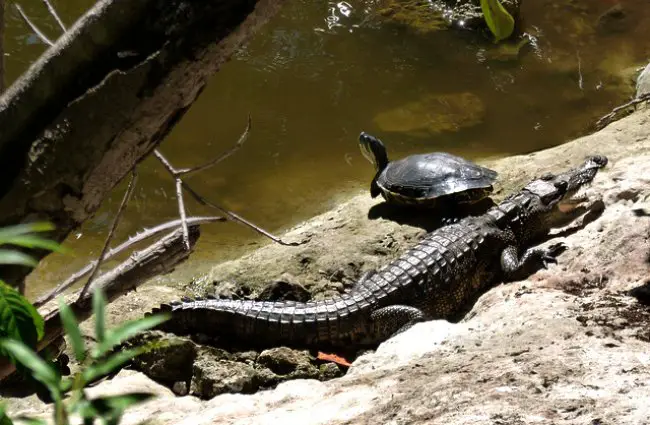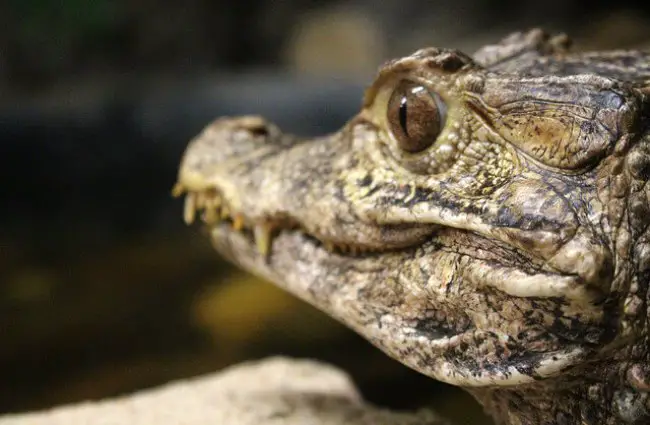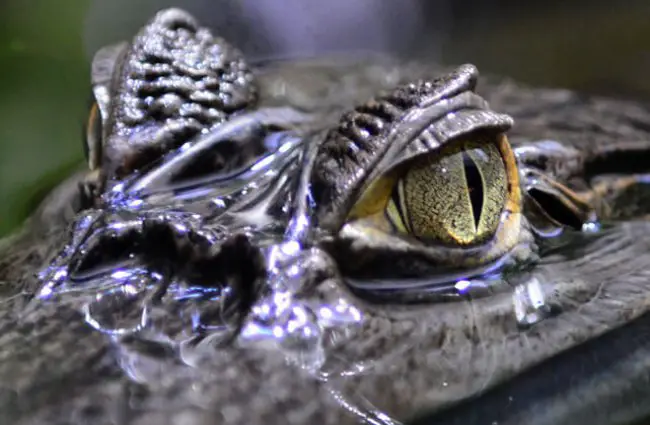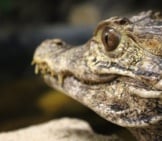Caimans are relatively small members of the crocodile family found in South and Central America. There are six different species of this reptile. They are carnivorous, aquatic predators and, although they eat a large amount of fish, they also hunt small mammals, birds, other reptiles, and insects. Read on to learn about the caiman.
Description of the Caiman
Caimans are very similar in appearance to crocodiles and alligators. The average length for most of the caiman species is about 6.6 – 8 ft (2 – 2.5 m), but there are smaller dwarf species, and the gigantic black caiman which can reach a length of 20 ft (6.1 m). Females tend to be smaller than males.
Caimans are usually dull browns, grays, or greens to help keep them camouflaged while they are hunting. All of the caiman the species have a bony ridge that extends from the eyes, down the snout. They have large eyes to help them hunt at night.
Interesting Facts About the Caiman
Many people think that because caimans are reptiles, they are uninteresting animals with very simple behaviors and lifestyles. However, they live in a range of habitats, and have evolved some very interesting characteristics.
- Scutes – Caimans are armor-plated, which means that parts of their bodies are covered in bony plates or scales, overlaid with horn. These are called “scutes.”
- Calcium Rivets – There are calcium rivets on the scutes of caimans, which makes their hide stiffer than alligators and crocodiles, and therefore less valuable to humans.
- Color Changing – Some species, such as the common caiman, have a limited capability to change color. This ability is called “metachrosis.”
- Sex Determination – The temperature in the nest determines the sex of baby caimans.
- Summer Hibernation – In particularly dry summers or droughts, the caiman may dig a burrow, seal it, and go into a form of summer hibernation called “aestivation.”
Habitat of the Caiman
Caiman are aquatic reptiles that live in rivers, marshes, swamps, lakes, and mangroves. They usually prefer still or slowly-moving freshwater habitats, but some species will tolerate faster, brackish. or even saltwater habitats.
Distribution of the Caiman
Wild caimans are found naturally only in South and Central America. However, they are also kept as pets, and in zoos worldwide. They exist in other areas where they have escaped from farms or been released by pet owners who were no longer able to take care of them.
Diet of the Caiman
Young caimans eat amphibians, small fishes, aquatic insects, crustaceans, and snails. Adults tend to eat larger vertebrates, such as medium-sized mammals (e.g. wild boar, capybaras), big fish, reptiles, and birds. If the climate becomes very dry, and their hunting water becomes shallow, they sometimes start to eat each other (cannibalism).
Caiman and Human Interaction
The main predators of caimans are humans, who hunt them for skin and meat, and also collect their eggs. This has severely reduced the numbers of some caiman species. They are also prone to deforestation and habitat degradation. Caimans sometimes inhabit commercial fish ponds, livestock water sources, or attack livestock, which makes them a problem species.
Domestication
Some species of caimans have been farmed for their skins and meat, but they have not been domesticated.
Does the Caiman Make a Good Pet
No. Caimans are difficult to handle, difficult to house, and expensive to keep. They can be extremely aggressive, and unexpectedly inflict serious wounds on their keepers. As with other crocodilians, they are almost impossible to tame.
Caiman Care
Most people obtain caiman when they are babies, not realizing the great size and strength they will develop as adults. Caimans therefore need a large and strong enclosures. Because they are aquatic in the wild, they require a large source of water in captivity.
Behavior of the Caiman
Caimans are largely active at night (nocturnal). They usually spend the day submerged in water, or in burrows they dig into the banks of waterways. Some caimans live in loose-knit groups, whereas others are solitary and develop small home ranges. They have a range of communication calls such as bellows, growls and hisses.
Before hatching, juveniles emit chirping calls to synchronize hatching with the other babies. Hatchlings also give distress calls when they need the protection of their parents. When threatened, some caiman species inflate their bodies to exaggerate their size, and they can also hiss loudly to scare off predators.
Reproduction of the Caiman
Spectacled caimans become sexually mature at 4 – 7 years of age. Females build a large nest of soil and vegetation which can be more than 5 ft (1.5 m) wide. They lay 14 – 60 eggs (depending on the species) in the nest, and cover them with more vegetation. Other females may share the nest, and the duty of guarding it, and are sometimes helped by males.
After about 70 days, the eggs hatch. In some species, the sex of the babies depends on the temperature in the nest. For example, an average nest temperature of 86º F (30º C) will produce mostly females, and 93.2º F (34º C) will produce mostly males.
Once hatched, the mother takes her young (and perhaps those of other females who laid in the nest) in groups called “pods” to a pool of shallow water, where they start learning to swim and hunt. Only 10% of young caimans live to 1-year of age due to predation by birds, cats, fish, otters, and other caimans.









![Red Angus Closeup of a beautiful Red Angus cowPhoto by: U.S. Department of Agriculture [pubic domain]https://creativecommons.org/licenses/by/2.0/](https://animals.net/wp-content/uploads/2020/03/Red-Angus-4-238x178.jpg)












![Red Angus Closeup of a beautiful Red Angus cowPhoto by: U.S. Department of Agriculture [pubic domain]https://creativecommons.org/licenses/by/2.0/](https://animals.net/wp-content/uploads/2020/03/Red-Angus-4-100x75.jpg)

